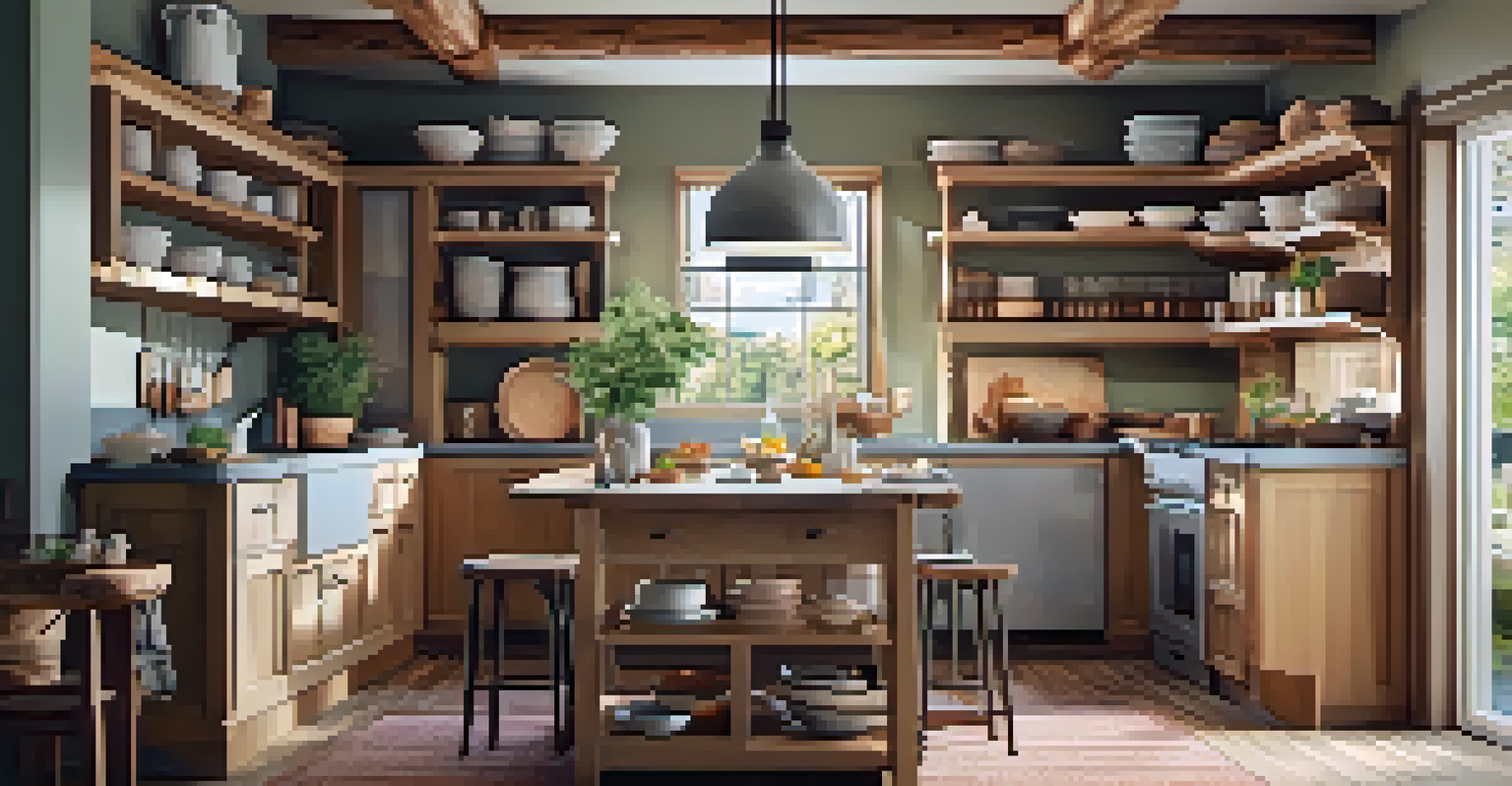Renovating Your Kitchen: Key Considerations and Ideas

Defining Your Kitchen Renovation Goals
Before diving into any renovation project, it's crucial to define your goals. Are you looking to increase functionality, improve aesthetics, or boost your home's value? Identifying your primary objectives will guide your design choices and help you stay focused throughout the process.
The kitchen is the heart of the home.
Consider the needs of your household. Do you entertain frequently, or is your kitchen primarily a cooking space? Understanding how you use your kitchen daily can help you prioritize features like an island for prep work or a dining nook for family gatherings.
Lastly, set a realistic budget. Knowing how much you can spend upfront will help you avoid overspending and keep your renovation on track. Allocate funds for unexpected expenses, as they often arise during renovations, ensuring you can adapt without stress.
Choosing the Right Layout for Your Space
The layout of your kitchen significantly affects its functionality. Consider popular designs like the U-shaped, L-shaped, or galley layout, which maximize space and efficiency. Each layout has its pros and cons, so think about how you prefer to move around while cooking.

For instance, if you often have multiple cooks in the kitchen, an open layout that allows for easy movement is ideal. On the other hand, if you enjoy a cozy cooking experience, a U-shaped kitchen might be perfect, providing ample counter space and storage.
Define Your Renovation Goals
Clearly identifying your kitchen renovation goals will guide your design choices and keep your project focused.
Don't forget to factor in the work triangle— the optimal distance between the sink, stove, and refrigerator. A well-planned layout minimizes movement and makes cooking a breeze, allowing you to enjoy your time in the kitchen even more.
Selecting the Right Materials and Finishes
When it comes to kitchen renovations, the materials and finishes you choose can make or break your design. Opt for durable materials that can withstand heat, moisture, and daily wear and tear, such as quartz or granite countertops.
Design is not just what it looks like and feels like. Design is how it works.
Additionally, think about the finishes that will best reflect your style. For a sleek, modern look, consider stainless steel appliances and matte cabinetry. Alternatively, if you prefer a more rustic feel, wooden accents and warm colors can create a welcoming atmosphere.
Be mindful of maintenance requirements as well. Some materials may require more upkeep than others, so choose finishes that align with your lifestyle. A well-thought-out selection will enhance both the beauty and longevity of your kitchen.
Incorporating Smart Technology in Your Kitchen
In today's digital age, smart technology can elevate your kitchen experience. From smart refrigerators that help you track groceries to voice-activated assistants that offer cooking tips, integrating technology can add convenience and efficiency.
Consider smart lighting systems that allow you to adjust brightness or color with a simple command, creating the perfect ambiance for any occasion. Additionally, smart ovens can be preheated remotely, making meal prep feel effortless.
Maximize Storage with Creativity
Utilizing inventive storage solutions can keep your kitchen organized and clutter-free, enhancing both functionality and aesthetics.
While incorporating technology, ensure that it complements your kitchen's design. A seamless integration will not only enhance functionality but also create a cohesive aesthetic that reflects your personal style.
Maximizing Storage Solutions for a Clutter-Free Kitchen
A well-organized kitchen is essential for both functionality and aesthetics. To maximize storage, consider creative solutions like pull-out cabinets, lazy Susans, and deep drawers that can accommodate pots and pans.
Utilizing vertical space is another effective strategy. Install shelving above countertops or use hanging racks for pots and utensils to keep your kitchen tidy and accessible. This not only frees up counter space but also adds character to your kitchen.
Don't forget about hidden storage options, such as under-sink cabinets or islands with built-in storage. These clever designs can help you maintain a clutter-free space while ensuring everything you need is within reach.
Choosing the Right Color Palette for Your Kitchen
Color plays a crucial role in setting the mood of your kitchen. Whether you prefer bold, vibrant hues or soft, muted tones, your color palette can greatly influence the overall atmosphere. Consider colors that reflect your personality and complement your home’s existing style.
For instance, if you want a fresh and airy feel, light shades like whites, creams, or soft pastels can work wonders. If you’re aiming for a more dramatic look, deep blues or earthy greens can create a cozy, inviting space.
Lighting Sets the Kitchen Mood
Effective lighting is essential in a kitchen, combining safety, functionality, and ambiance to create an inviting space.
Don’t forget to consider the impact of color on your kitchen's size perception. Lighter colors can make a small kitchen feel larger, while darker shades can add warmth to more expansive spaces. Choose wisely to achieve the desired effect.
Lighting: Enhancing Functionality and Ambiance
Lighting is a critical element in kitchen design, influencing both functionality and ambiance. A well-lit kitchen ensures safety while cooking and enhances the overall aesthetic. Start with ambient lighting to illuminate the entire space, then layer in task and accent lighting for specific areas.
For example, pendant lights above the island provide focused lighting for meal prep, while under-cabinet lights brighten countertops for easier cooking. Consider dimmable options to adjust the mood during different occasions, from lively gatherings to quiet dinners.

Moreover, natural light should not be overlooked. If possible, maximize windows or consider a skylight to bring in daylight, creating a warm and inviting atmosphere. A well-lit kitchen will not only be functional but also a delightful space to gather with family and friends.